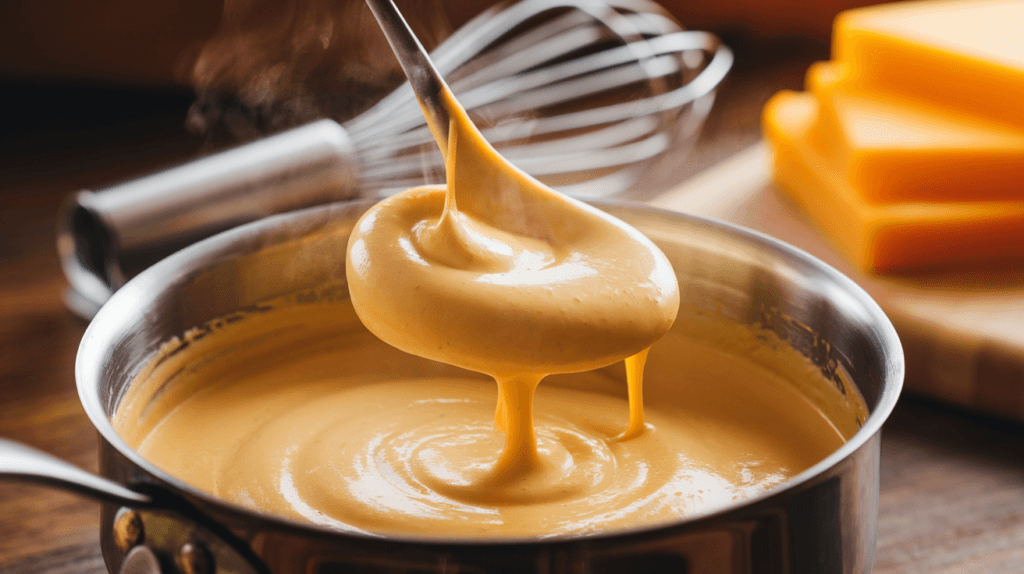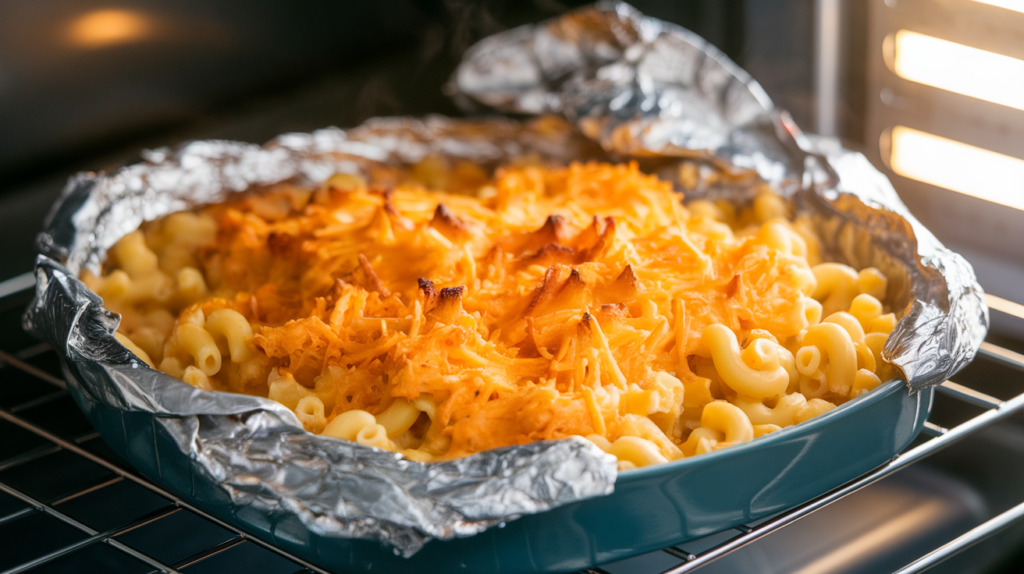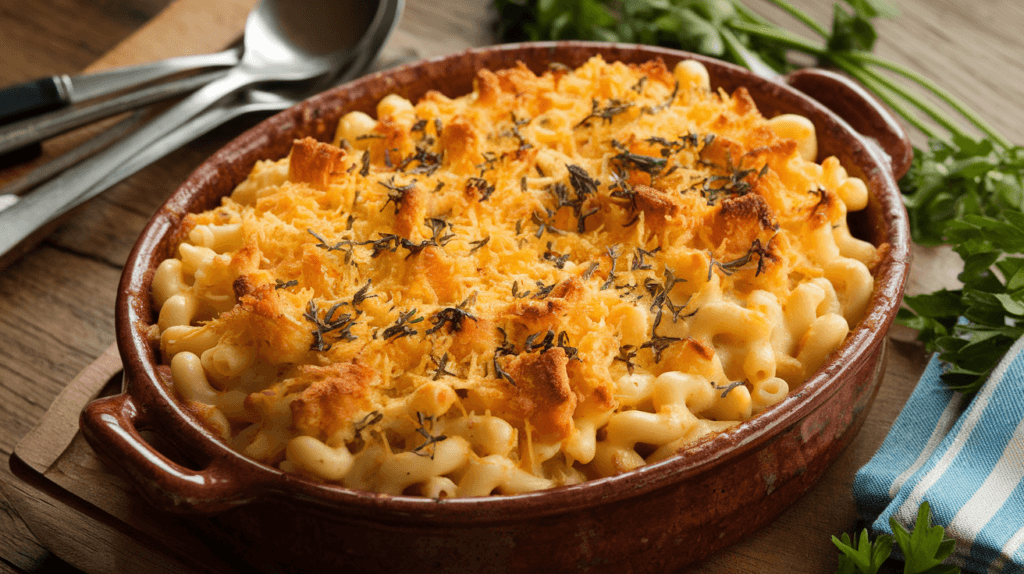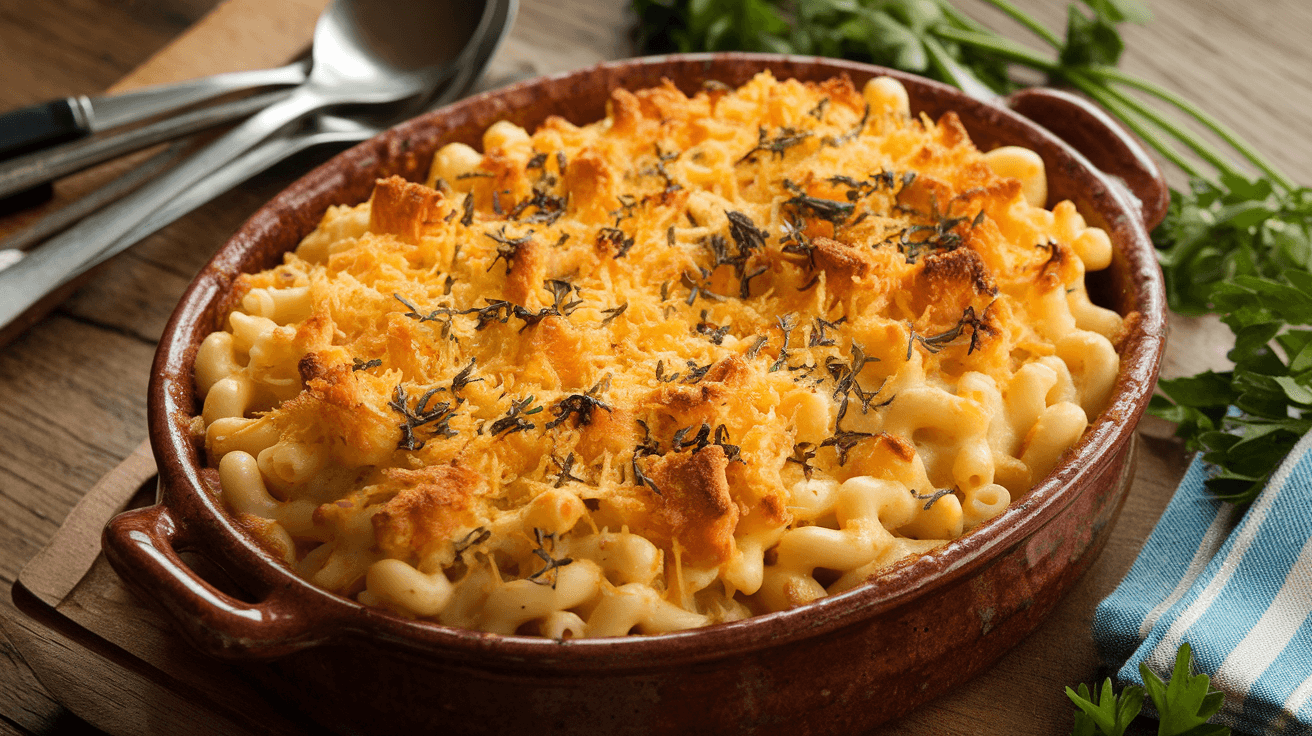Introduction
Mac and cheese is a timeless comfort food, loved for its creamy texture and cheesy flavor. However, figuring out how to keep mac and cheese moist in the oven can be a challenge. Baking mac and cheese in the oven sometimes results in dry, unappetizing dishes. The secret to achieving the perfect baked mac and cheese lies in understanding the factors that impact moisture and applying techniques that ensure it stays luscious, creamy, and moist.
In this guide, we’ll explore everything you need to know to keep your mac and cheese moist in the oven, from preparation tips to baking techniques and ingredient choices. Whether you’re preparing a weeknight dinner or a dish for a special occasion, these tips will help you achieve creamy, moist perfection every time.
What Causes Mac and Cheese to Dry Out in the Oven?
How Overbaking Dries Out Mac and Cheese
One of the most common reasons mac and cheese becomes dry is overbaking. Understanding how to keep mac and cheese moist in the oven means avoiding excessive heat and baking time. When exposed to high heat for too long, the cheese sauce loses its moisture and separates, leaving behind a gritty texture. Overbaking not only dries out the dish but can also make the top layer overly crispy, overpowering the creamy and moist interior.
Insufficient Sauce-to-Pasta Ratio
If there isn’t enough sauce to coat the pasta thoroughly, the dish will turn out dry. Pasta absorbs a significant amount of liquid during cooking and baking, so an inadequate amount of sauce will leave the noodles dry and unappealing.
Lack of Moisture-Rich Ingredients
Skipping key ingredients that add moisture—like milk, cream, or specific types of cheese—can lead to a dry result. A proper balance of moisture-rich ingredients ensures that the sauce remains creamy and luscious throughout the baking process.
No Protective Cover While Baking
Baking mac and cheese uncovered allows moisture to evaporate rapidly. Without a protective layer, such as aluminum foil, the dish is exposed to direct heat, which can dry out the cheese and pasta.
Improper Pasta Cooking
Cooking the pasta until it’s completely soft before baking can contribute to dryness. Overcooked pasta doesn’t hold up well during the baking process and may become mushy and absorb too much sauce, leaving the dish dry.
How to Keep Mac and Cheese Moist While Baking
Cook Pasta Al Dente
Start by cooking your pasta until it is al dente. This is a crucial step in understanding how to keep mac and cheese moist in the oven. Al dente pasta, which is firm to the bite, will continue cooking in the oven, absorbing just the right amount of sauce. This prevents the dish from becoming mushy or overly dry, ensuring a perfectly moist and creamy texture.
Why Adding Extra Sauce Keeps Mac and Cheese Moist
Always ensure there is an ample amount of cheese sauce to coat the pasta. A good rule of thumb is to make at least 1 1/2 to 2 cups of sauce for every cup of pasta. This helps the dish retain its creamy texture even after baking.
Creamy Ingredients That Keep Baked Mac and Cheese Moist
Incorporate moisture-rich ingredients such as heavy cream, whole milk, or sour cream into the cheese sauce. These ingredients help maintain a velvety consistency and prevent the sauce from drying out during baking.
Top with a Protective Layer
If you’re using breadcrumbs or shredded cheese as a topping, lightly drizzle melted butter or a bit of cream over the top before baking. This adds an extra layer of moisture and prevents the topping from becoming too dry.
Cover with Foil During Baking
To retain moisture, cover your baking dish with aluminum foil for the first 15-20 minutes of baking. This traps steam and keeps the cheese sauce from drying out. Remove the foil toward the end of the baking time to achieve a golden-brown crust.
Use the Right Cheese Combination
Opt for a mix of cheeses that melt smoothly, such as cheddar, mozzarella, and Gruyere. Avoid using only hard cheeses, as they can become stringy and dry. The right blend ensures a creamy and moist texture throughout.
Don’t Overbake
Monitor the baking time closely. Most baked mac and cheese recipes only need about 20-30 minutes in the oven. Overbaking will dry out the cheese sauce and leave the pasta less creamy.
Ingredients to Keep Mac and Cheese Creamy and Moist

Milk and Cream
The base of your cheese sauce is essential when learning how to keep mac and cheese moist in the oven. Including milk and cream ensures maximum moisture in the dish. Whole milk offers a balanced combination of fat and liquid, while heavy cream adds a luxurious texture that prevents the sauce from drying out during baking.
Butter
Butter is a key ingredient in creating a creamy cheese sauce. When melted and combined with flour to form a roux, it helps thicken the sauce while adding richness and moisture to the dish.
Egg Yolks
Incorporating egg yolks into the cheese sauce can create a custard-like texture that locks in moisture. Whisk the yolks into the warm sauce for added creaminess, but avoid overheating to prevent curdling.
Sour Cream or Greek Yogurt
For an extra creamy texture, mix in sour cream or Greek yogurt. These ingredients add tangy flavor and moisture, keeping the mac and cheese soft and moist during baking. They also prevent the cheese sauce from drying out.
Cheese Selection
Choosing the right combination of cheeses is crucial for maintaining moisture. Opt for high-moisture cheeses like mozzarella, Monterey Jack, and Havarti. These cheeses melt well and create a creamy sauce that stays moist in the oven.
Vegetable Purees
For a healthy twist, consider blending cooked vegetables like butternut squash or cauliflower into the cheese sauce. These purees not only add nutrients but also provide additional moisture to the dish.
Broth or Stock
Adding a small amount of chicken or vegetable broth to the cheese sauce can enhance the flavor and keep the dish moist. This works especially well if you’re aiming for a lighter sauce with a silky consistency.
Baking Techniques to Keep Mac and Cheese Moist

Preheat the Oven
Always preheat your oven before placing the mac and cheese inside. An even and stable temperature ensures the dish cooks uniformly, reducing the chances of drying out any part of the cheese sauce or pasta.
Use the Right Baking Dish
Select a baking dish with a snug fit for your mac and cheese. Avoid oversized pans, as they expose more surface area to heat, which can cause moisture to evaporate quickly. Glass or ceramic dishes work best for retaining heat and moisture.
Cover Your Mac and Cheese to Lock in Moisture
Cover the baking dish with aluminum foil for the first 15-20 minutes of baking. This traps steam inside, keeping the cheese sauce moist. Uncover the dish for the final 5-10 minutes to achieve a golden, slightly crispy topping.
Control the Temperature
Bake your mac and cheese at a moderate temperature, ideally between 350°F (175°C) and 375°F (190°C). High heat can dry out the sauce and overcook the pasta, while lower heat helps preserve moisture.
Add Liquid Mid-Bake
If you notice the edges of your mac and cheese drying out, add a small amount of milk, cream, or broth around the edges of the dish. This can rehydrate the sauce and ensure even moisture throughout the dish.
Choose the Right Topping Technique
If using breadcrumbs, mix them with melted butter before sprinkling over the dish. This creates a protective barrier that prevents the topping from absorbing too much moisture from the sauce, keeping the dish creamy underneath.
Rest Before Serving
After removing the dish from the oven, let it rest for 5-10 minutes. This allows the sauce to settle and thicken, ensuring a creamy, moist texture. Cutting into the dish too soon can cause the sauce to separate or dry out.
Mistakes to Avoid When Baking Mac and Cheese
Using Low-Quality Cheese
Low-quality or pre-shredded cheeses often contain anti-caking agents that can prevent smooth melting. Always opt for freshly grated, high-quality cheeses to ensure a creamy, moist texture in your mac and cheese.
Skipping the Roux
A roux made of butter and flour is essential for thickening the cheese sauce. Skipping this step can result in a watery sauce that doesn’t cling to the pasta properly, leaving the dish unevenly moist.
Adding Cheese All at Once
Dumping all the cheese into the sauce at once can cause it to clump or become grainy. Instead, add cheese gradually, stirring constantly to ensure smooth melting and even distribution.
Baking Too Long
Overbaking is a common mistake that leads to dry mac and cheese. Stick to the recommended baking time and monitor the dish closely to prevent the sauce from drying out.
Not Tasting the Sauce Before Baking
Always taste your cheese sauce before combining it with the pasta. Under-seasoned sauce can result in bland mac and cheese, even if it’s perfectly moist.
Recipe for Moist Mac and Cheese
Ingredients:
- 3 cups elbow macaroni (cooked al dente)
- 4 tablespoons unsalted butter
- 4 tablespoons all-purpose flour
- 2 cups whole milk
- 1 cup heavy cream
- 2 cups shredded cheddar cheese
- 1 cup shredded mozzarella cheese
- 1/2 cup grated Parmesan cheese
- 1 teaspoon mustard powder
- Salt and pepper to taste
- 1/2 cup breadcrumbs (optional)
- 2 tablespoons melted butter (optional, for breadcrumbs)
Instructions:
- Preheat your oven to 350°F (175°C).
- In a saucepan, melt butter over medium heat. Add flour and whisk continuously to form a roux. Cook for 1-2 minutes.
- Gradually add milk and cream, whisking to create a smooth mixture. Bring to a simmer.
- Reduce heat to low and stir in cheddar, mozzarella, and Parmesan cheese a handful at a time. Add mustard powder, salt, and pepper. Mix until smooth.
- Combine the cheese sauce with cooked macaroni, ensuring the pasta is evenly coated.
- Transfer the mixture to a greased baking dish. If using breadcrumbs, mix them with melted butter and sprinkle over the top.
- Cover the dish with aluminum foil and bake for 20 minutes. Remove the foil and bake for an additional 5-10 minutes until the top is golden brown.
- Let the mac and cheese rest for 5 minutes before serving.
FAQs
Can I use low-fat milk instead of whole milk for mac and cheese?
Yes, you can use low-fat milk, but it may affect the creaminess of the cheese sauce. To maintain moisture and richness, consider adding a small amount of heavy cream or butter if using low-fat milk.
Why is my cheese sauce gritty?
Gritty cheese sauce can result from adding cheese at too high a temperature. Always reduce the heat to low and add cheese gradually, stirring constantly to ensure smooth melting.
Can I make moist mac and cheese ahead of time?
Yes, you can prepare mac and cheese in advance. Assemble the dish and refrigerate it before baking. When ready to bake, add a splash of milk or cream to maintain moisture, and cover the dish while baking to prevent it from drying out.
What’s the best cheese combination for moist mac and cheese?
A mix of cheddar, mozzarella, and Gruyere works well for creamy, moist mac and cheese. These cheeses melt smoothly and provide a balance of flavor and texture.
How do I reheat mac and cheese without drying it out?
To reheat mac and cheese, add a small amount of milk or cream and cover it with foil before warming it in the oven at 325°F (160°C). Stir occasionally to redistribute the moisture evenly.
Can I skip the baking step and serve stovetop mac and cheese?
Absolutely! Stovetop mac and cheese is naturally creamier and avoids the drying risks of baking. Just ensure your cheese sauce has the right consistency, and serve it immediately for the best texture.
Conclusion

Keeping mac and cheese moist in the oven is all about balancing the right ingredients, preparation methods, and baking techniques. From using a rich cheese sauce to covering the dish while baking, these tips ensure a creamy and satisfying result every time.
By avoiding common mistakes and implementing the strategies shared in this guide, you can master the art of moist, flavorful mac and cheese. Whether you’re hosting a dinner party or preparing a family meal, your baked mac and cheese is sure to be a hit!

